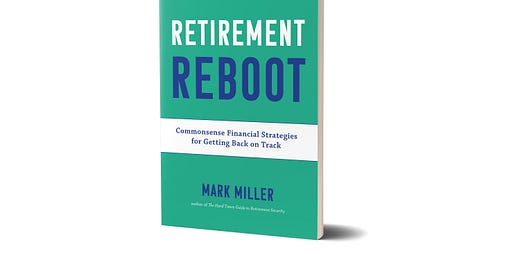CORRECTED: Some politicians want to raise Social Security's full retirement age again
But the actual claiming data shows this would be a very damaging move - especially for younger workers.
Note to readers: I’m re-sending this morning’s newsletter to correct two errors on the projected Social Security trust fund depletion date, and the description of the benefit cut that would occur at that point. Thanks to several alert readers for catching these and letting me know! Here’s the corrected version:
The latest financial forecast from the Social Security trustees shows that the program’s trust fund will be depleted in 2033. At that point, Americans will receive just 77% of their promised benefits, unless Congress takes action.
The report serves as a reminder of the need for Social Security reform. The topic is off the table during this year’s fight over the debt ceiling - and that’s as it should be. Social Security reform should be done with care and deliberation, not in the heat of a battle over avoiding a catastrophic debt default. But we do know how the two political parties hope to address Social Security reform - at some point.
Democrats generally favor shoring up the program’s finances by adding new taxes on the wealthy. Republican positions vary, but the only substantive proposal, from conservatives in the House of Representatives, would gradually raise the full retirement age (when you can receive 100% of your earned benefit) to 70, among other changes.
Politicians often pitch a higher Full Retirement Age (FRA) as a way to “save” Social Security for today’s younger workers. But a close look at the numbers on claiming tell a different story.
My latest Morningstar column examines the trends.
Retirement Reboot snippets
I’ll be running some factoids and snippets here from my new book, Retirement Reboot: Commonsense Financial Strategies for Getting Back on Track. Today, a brief snippet from the chapter on optimizing Social Security benefits:
Married couples should have a coordinated claiming strategy for Social Security.
Couples have a range of options. Should one or the other spouse start benefits early, should both delay, or should both file early? Most often, couples will benefit if the higher-benefit spouse delays filing to earn delayed credits. An oft-cited Census Bureau statistic is that women earn 82 cents for every dollar earned by men. But some estimates have found a larger gap—49 cents on the dollar in 2015 when the broadest possible definition of workers is used. If your household’s income history reflects that kind of gender gap, a sensible approach might call for the wife to file earlier to start the flow of benefits into the household, offsetting living expenses. Another reason for her not to delay too long: those higher-earning men tend to die at earlier ages. At that point, the lower earner steps up to 100 percent of the deceased spouse’s benefit—and any increased benefit gained from her own delay vanishes at that point.
The man’s benefit becomes an extended joint-life benefit for his survivor.
A coordinated delay strategy increases the odds that lifetime benefits will be greater, because one of the two are very likely to beat their break- even age.
Another important thing to understand about the spousal benefit: you don’t actually apply for it. When you apply for Social Security, you will receive any benefit that you have earned through your own work, but if it is less than 50 percent of your spouse’s full benefit, you get a spousal benefit to make up the difference. This feature is available only if your spouse is retired and collecting benefits. The amount of the spousal benefit is reduced if you claim it before your full retirement age, but it is not increased past that age.
What I’m reading
Attitudes about retirement diverge sharply among men and women . . . Do older people work harder? Some bosses think so . . . How to define “risk” . . . Inflation, deflation, confiscation and devastation - the four horsemen of risk . . . Older adults face higher rates of rejection for mortgages.



